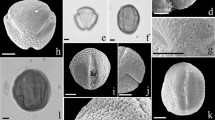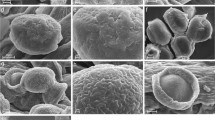Summary
Molecular phylogenetic studies have revealed an entirely holoparasitic Boschniakia–Epifagus clade within Orobanchaceae. Pollen morphology of seven species, four studied for the first time, belonging to five currently recognised genera was studied using both light and scanning electron microscopy. Pollen grains are (2 –) 3 (– 4)-colpate, rarely 3-colporate and inaperturate (reported in Epifagus for the first time); suboblate to prolate (P/E = 0.77 – 1.56) in shape; medium and rarely small-sized: Polar axis = 14.63 – 34.58 µm, Equatorial diameter = 14.63 – 30.59 µm. Colpi are long, medium-length or short, wide or narrow, and acute, obtuse, or with indistinct ends. Exine sculpture is rather diverse: reticulate, microreticulate, rugulate-granulate, granulate-perforate, rugulate-perforate, and granulate. The data obtained demonstrate that pollen grains of the studied taxa are morphologically rather diverse and can, therefore, be distinguished at the levels of genera and species. The diagnostic features include shape and size of pollen grains, length and width of colpi, exine thickness in mesocolpia and apocolpia, and exine sculpture. Palynomorphological data are interpreted within the current phylogenetic framework. An UPGMA dendrogram, based on quantitative characters of the pollen grains, supports the status of Xylanche as a genus.






Similar content being viewed by others
References
Albach, D. C., Tsymbalyuk, Z. M. & Mosyakin, S. L. (2021). Pollen morphology of Ellisiophyllum and Sibthorpia (Plantaginaceae, tribe Sibthorpieae) and phylogenetics of the tribe. Pl. Syst Evol. 307 (66): 1 – 15. https://doi.org/10.1007/s00606-021-01786-9
Bennett, J. R. & Mathews, S. (2006). Phylogeny of the parasitic plant family Orobanchaceae inferred from phytochrome A. Amer. J. Bot. 93 (7): 1039 – 1051. https://doi.org/10.3732/ajb.93.7.1039
Bezusko, L. G. & Tsymbalyuk, Z. M. (2011). Palynotheca of the M. G. Kholodny Institute of Botany, National Academy of Sciences of Ukraine. In: N. M. Shiyan (ed), Herbaria of Ukraine. Index Herbariorum Ucrainicum, pp. 138 – 141. Alterpress, Kyiv [in Ukrainian].
Brummitt, R. K. & Powell, C. E. (1992). Authors of plant names. A list of authors of scientific names of plant, with recommended standard forms of their names, including abbreviations. Royal Botanic Gardens, Kew.
Coutinho, A. P., Silveira, P. C., Portugal, A., Albuquerque, J. I. & Pujadas-Salvà, A. J. (2019). Contribution to the knowledge of the pollen morphology in the tribe Orobancheae Lam. & DC. (Orobanchaceae). Grana 58 (1): 14 – 44. https://doi.org/10.1080/00173134.2018.1519032
dePamphilis, C. W., Young, N. D. & Wolfe, A. D. (1997). Evolution of plastid gene rps2 in a lineage of hemiparasitic and holoparasitic plants: many losses of photosynthesis and complex patterns of rate variation. Proc. Natl. Acad. Sci. U.S.A. 94 (14): 7367 – 7372. https://doi.org/10.1073/pnas.94.14.7367
Erdtman, G. (1952). Pollen morphology and plant taxonomy: an introduction to palynology. Angiosperms. Almquist & Wiksell, Stockholm.
Fischer, E. (2004). Scrophulariaceae. In: K. Kubitzki (ed), The families and genera of vascular plants. 7, pp. 333 – 432, Springer, Berlin.
Fu, W., Liu, X., Zhang, N., Song, Z., Zhang, W., Yang, J. & Wang, Y. (2017). Testing the hypothesis of multiple origins of holoparasitism in Orobanchaceae: Phylogenetic evidence from the last two unplaced holoparasitic genera, Gleadovia and Phacellanthus. Frontiers Pl. Sci. 8 (1380): 1 – 9. https://doi.org/10.3389/fpls.2017.01380
Furness, C. A. (2007). Why does some pollen lack apertures? A review of inaperturate pollen in eudicots. Bot. J. Linn. Soc. 155 (1): 29 – 48. https://doi.org/10.1111/j.1095-8339.2007.00694.x
Halbritter, H., Ulrich, S., Grímsson, F., Weber, M., Zetter, R., Hesse, M., Buchner, R., Svojtka, M. & Frosch-Radivo, A. (2018). Illustrated Pollen Terminology. 2nd edition. Springer International Publishing, Cham. https://doi.org/10.1007/978-3-319-71365-6
Hammer, Ø., Harper, D. A. T. & Ryan, P. D. (2001). Past: Paleontological Statistics Software Package for Education and Data Analysis. Palaeontologia Electronica 4 (1): 1 – 9.
IPNI (2023). International Plant Names Index. Royal Botanic Gardens, Kew, Harvard University Herbaria & Libraries and Australian National Botanic Gardens. Available from: http://www.ipni.org. [Accessed 7 Feb. 2023]
Li, X., Jang, T. S., Temsch, E. M., Kato, H., Takayama, K. & Schneeweiss, G. M. (2017). Molecular and karyological data confirm that the enigmatic genus Platypholis from Bonin Islands (SE Japan) is phylogenetically nested within Orobanche (Orobanchaceae). J. Pl. Res. 130 (2): 273 – 280. https://doi.org/10.1007/s10265-016-0888-y
____, Feng, T., Randle, C. & Schneeweiss, G. M. (2019). Phylogenetic relationships in Orobanchaceae inferred from low-copy nuclear genes: Consolidation of major clades and identification of a novel position of the non-photosynthetic Orobanche clade sister to all other parasitic Orobanchaceae. Frontiers Pl. Sci. 10 (902): 1 – 14. https://doi.org/10.3389/fpls.2019.00902
Manen, J. F., Habashi, C., Jeanmonod, D., Park, J. M. & Schneeweiss, G. M. (2004). Phylogeny and intraspecific variability of holoparasitic Orobanche (Orobanchaceae) inferred from plastid rbcL sequences. Molec. Phylogenet. Evol. 33 (2): 482 – 500. https://doi.org/10.1016/j.ympev.2004.06.010
Mathews, S., Schneeweiss, G. M. & Yatskievych, G. (2008). Phylogenetic affinities of a new holoparasitic genus of Orobanchaceae endemic to Guerrero, Mexico, inferred from molecular data [Abstract]. Botany 2008 Conference. Vancouver. http://2008.botanyconference.org/engine/search/index.php?func=detail&aid=858. [Accessed 7 Feb. 2023]
McNeal, J. R., Bennett, J. R., Wolfe, A. D. & Mathews, S. (2013). Phylogeny and origins of holoparasitism in Orobanchaceae. Amer. J. Bot. 100 (5): 971 – 983. https://doi.org/10.3732/ajb.1200448
Minkin, J. P. & Eshbaugh, W. H. (1989). Pollen morphology of the Orobanchaceae and rhinanthoid Scrophulariaceae. Grana 28 (1): 1 – 18.
Mosyakin, S. L. & Tsymbalyuk, Z. M. (2015a). Pollen morphology of the southern African tribe Teedieae, an early-branching lineage of crown Scrophulariaceae. Willdenowia 45 (1): 65 – 75. https://doi.org/10.3372/wi.45.45107
____ & ____ (2015b). Pollen morphology of the tribes Aptosimeae and Myoporeae supports the phylogenetic pattern in early-branching Scrophulariaceae revealed by molecular studies. Willdenowia 45 (2): 209 – 222. https://doi.org/10.3372/wi.45.45207
____ & ____ (2017). Pollen morphology of the tribe Hemimerideae: possible evidence of ancestral pollen types and parallel evolution in the basalmost clade of Scrophulariaceae s.str. Willdenowia 47 (1): 15 – 27. https://doi.org/10.3372/wi.47.47102
Park, J. M., Manen, J. F., Colwell, A. E. & Schneeweiss, G. M. (2008). A plastid gene phylogeny of the non-photosynthetic parasitic Orobanche (Orobanchaceae) and related genera. J. Pl. Res. 121 (4): 365 – 376. https://doi.org/10.1007/s10265-008-0169-5
Piednoel, M., Aberer, A. J., Schneeweiss, G. M., Macas, J., Novak, P., Gundlach, H., Temsch, E. M. & Renner, S. S. (2012). Next-generation sequencing reveals the impact of repetitive DNA across phylogenetically closely related genomes of Orobanchaceae Molec. Biol. Evol. 29 (11): 3601 – 3611. https://doi.org/10.1093/molbev/mss168
Piwowarczyk, R., Madeja, J. & Nobis, M. (2015). Pollen morphology of the Central European broomrapes (Orobanchaceae: Orobanche, Phelipanche and Orobanchella) and its taxonomical implications. Pl. Syst Evol. 301 (2): 795 – 808. https://doi.org/10.1007/s00606-014-1117-6
POWO (2023). Plants of the World Online. Royal Botanic Gardens, Kew. Available from: http://www.plantsoftheworldonline.org. [Accessed 7 Feb. 2023]
Punt, W., Hoen, P. P., Blackmore, S., Nilsson, S. & Le Thomas, A. (2007). Glossary of pollen and spore terminology. Rev. Palaeobot. Palynol. 143 (1 – 2): 1 – 81. https://doi.org/10.1016/j.revpalbo.2006.06.008
Rodrigues, A. G., Alison, E. L., Colwell, A. & Stefanović, S. (2011). Molecular systematics of the parasitic genus Conopholis (Orobanchaceae) inferred from plastid and nuclear sequences. Amer. J. Bot. 98 (5): 896 – 908. https://doi.org/10.3732/ajb.1000375
____, Shaya, S., Dickinson, T. A. & Stefanović, S. (2013). Morphometric analyses and taxonomic revision of the North American holoparasitic genus Conopholis (Orobanchaceae). Syst. Bot. 38 (3): 795 – 804. https://doi.org/10.1600/036364413X670403
Schneeweiss, G. M. (2013). Phylogenetic relationships and evolutionary trends in Orobanchaceae. In: D. M. Joel, J. Gressel & L. J. Mussleman (eds), Parasitic Orobanchaceae, pp. 243 – 265. Springer, Berlin & Heidelberg.
____, Colwell, A., Park, J. M., Jang, C. G. & Stuessy, T. F. (2004). Phylogeny of holoparasitic Orobanche (Orobanchaceae) inferred from nuclear ITS sequence. Molec. Phylogenet. Evol. 30 (2): 465 – 478. https://doi.org/10.1016/s1055-7903(03)00210-0
Thiers, B. (2023 [continuously updated]). Index Herbariorum: A global directory of public herbaria and associated staff. New York Botanical Garden's Virtual Herbarium. Available from: https://sweetgum.nybg.org/science/ih/. [Accessed 7 Feb. 2023]
Tsymbalyuk, Z. M. (2016). Palynomorphological peculiarities of representatives of the order Lamiales s.l.: phylogenetic significance and main trends of evolution. M.G. Kholodny Institute of Botany NAS of Ukraine, Kyiv. PhD Thesis [in Ukrainian]. https://doi.org/10.13140/rg.2.2.17133.79843
____ & Mosyakin, S. L. (2013a). Palynomorphology of species of the Orobanche L. subgenus Phelipanche (Pomel) Tzvelev (Orobanchaceae) in the flora of Ukraine. Ukrainian Botanical Journal 70 (5): 600 – 609 (in Ukrainian). https://doi.org/10.15407/ukrbotj70.05.600
____ & ____ (2013b). Palynomorphology of species of Orobanche L. subgenus Orobanche (Orobanchaceae) in the flora of Ukraine. Ukrainian Bot. J. 70 (6): 723 – 731 [in Ukrainian]. https://doi.org/10.15407/ukrbotj70.06.723
____, Celenk, S., Mosyakin, S. L. & Nitsenko, L. M. (2021a). Pollen morphology of some species of the genus Cephalaria Schrad. (Caprifoliaceae) and its significance for taxonomy. Microscopy Research and Technique 84 (4): 682 – 694. https://doi.org/10.1002/jemt.23627
____, Ivanova, D. & Nitsenko, L. M. (2021b). Taxonomic significance of palynomorphological characteristics of selected Centranthus (Caprifoliaceae) species. Hacquetia 20 (2): 243 – 256. https://ojs.zrc-sazu.si/hacquetia/article/view/8825. [Accessed 7 Feb. 2023]
____, Celenk, S., Bell, C. D., Nitsenko, L. M. & Mosyakin, S. L. (2022a). Comparative palynomorphological study of the genus Symphoricarpos (Caprifoliaceae): exine sculpture and implications for evolution. Palynology 46 (4): 1 – 14. https://doi.org/10.1080/01916122.2022.2052993
____, Nitsenko, L. M. & Mosyakin, S. L. (2022b). The unique type of pollen grain of Dasistoma (Macranthera-Agalinis clade; Orobanchaceae): implications for taxonomy. Grana 61 (1): 1 – 12. https://doi.org/10.1080/00173134.2022.2130008
Wolfe, K. H., Morden, C. W. & Palmer, J. D. (1992). Function and evolution of a minimal plastid genome from a nonphotosynthetic parasitic plant. Proc. Natl. Acad. Sci. U.S.A. 89 (22): 10648 – 10652. https://doi.org/10.1073/pnas.89.22.10648
Wolfe, A. D., Randle, C. P., Liu, L. & Steiner, K. E. (2005). Phylogeny and biogeography of Orobanchaceae. Folia Geobot. 40: 115 – 134. https://doi.org/10.1007/BF02803229
Yatskievych, G. & Contreras Jiménez, J. L. (2009). A new genus of holoparasitic Orobanchaceae from Mexico. Novon 19 (2): 266 – 276. https://doi.org/10.3417/2008088
Yu, W. B. (2013). Nomenclatural clarifications for names in Boschniakia, Kopsiopsis and Xylanche (Orobanchaceae). Phytotaxa 77 (3): 40 – 42. https://doi.org/10.11646/phytotaxa.77.3.1
Zare, G., Dönmez, A. A. & Dönmez, E. O. (2014). Pollen morphology and evolution in the genus Orobanche L. s.l. and its allied genera (Orobancheae/Orobanchaceae) in Turkey. Pl. Syst. Evol. 300 (5): 783 – 802. https://doi.org/10.1007/s00606-013-0919-2
Zhang, Z. Y. & Tzvelev, N. N. (1998). Orobanchaceae. In: Z. Y. Wu, P. H. Raven & D. Y. Hong (eds), Flora of China. (Scrophulariaceae through Gesneriaceae) 18: 229 – 243. Science Press, Beijing & Missouri Botanical Garden Press, St. Louis.
Acknowledgements
The authors express their gratitude to James C. Solomon, Head Curator of the Missouri Botanical Garden Herbarium (MO; St. Louis, Missouri, USA), and Natalia M. Shyian, Head Curator of the National Herbarium of Ukraine (KW; herbarium of the M.G. Kholodny Institute of Botany, National Academy of Sciences of Ukraine). The kind help and cooperation of Dmytro O. Klymchuk, Head of the Center of Electron Microscopy (M.G. Kholodny Institute of Botany, National Academy of Sciences of Ukraine), are greatly appreciated. The authors are very grateful to Gerald M. Schneeweiss (University of Vienna, Austria) for his valuable comments and critically reading and substantially improving the manuscript. The authors are grateful to anonymous reviewers for their detailed review of the manuscript, valuable comments and suggestions.
Author information
Authors and Affiliations
Corresponding author
Ethics declarations
Disclosure statement
The authors declare that they have no conflict of interest.
Additional information
Publisher's note
Springer Nature remains neutral with regard to jurisdictional claims in published maps and institutional affiliations.
Rights and permissions
Springer Nature or its licensor (e.g. a society or other partner) holds exclusive rights to this article under a publishing agreement with the author(s) or other rightsholder(s); author self-archiving of the accepted manuscript version of this article is solely governed by the terms of such publishing agreement and applicable law.
About this article
Cite this article
Tsymbalyuk, Z.M., Mosyakin, S.L. & Nitsenko, L.M. Pollen morphology of the Boschniakia–Epifagus clade (Orobanchaceae): implications for taxonomy and phylogeny. Kew Bull 78, 563–575 (2023). https://doi.org/10.1007/s12225-023-10131-x
Accepted:
Published:
Issue Date:
DOI: https://doi.org/10.1007/s12225-023-10131-x




